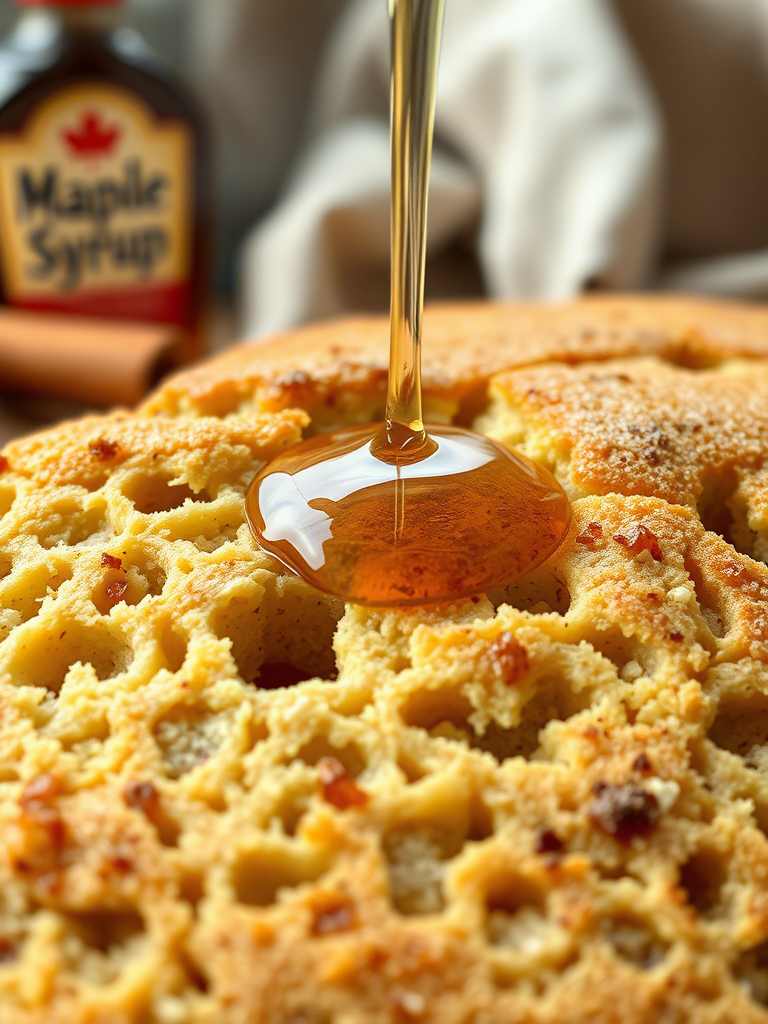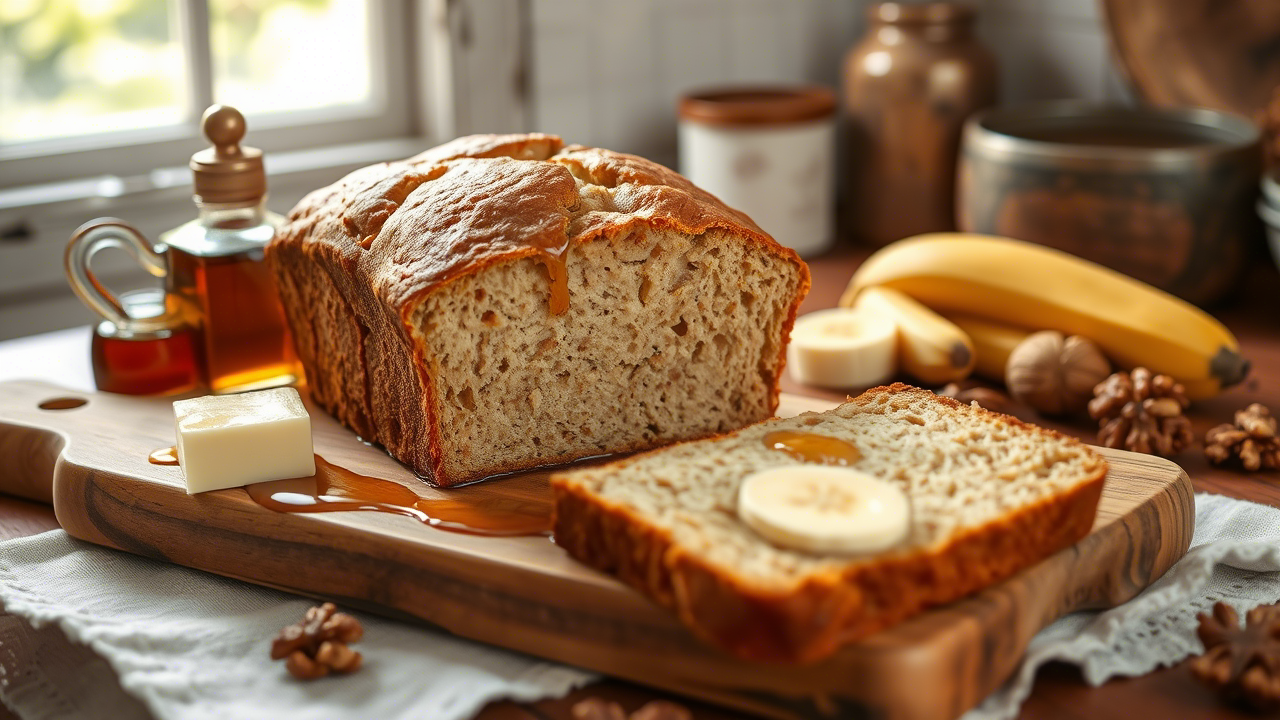It’s dense. It’s rich. It’s moist in that golden, never-gummy kind of way. But this isn’t your granny’s banana bread. No offense, gran. This loaf is quietly jacked—protein-packed and naturally sweetened with a whisper of maple. And the real kicker? Cottage cheese. Yeah, that unassuming tub in your fridge finally gets its star role. Welcome to the world of Protein-Packed Cottage Cheese Banana Bread with Maple Sweetness—where classic comfort meets modern nutrition science.
We’re gonna take a deep, chewy bite into what makes this loaf not just a tasty treat, but a strategic move in the world of performance baking. Whether you’re fueling clients post-lift, reinventing your bakery’s healthy menu, or tweaking recipes for macro balance, this is one for the books.
Why Protein in Banana Bread? Because Balance
Carbs and fats have always dominated banana bread. It’s sweet. It’s buttery. It leans hard into comfort. But the protein? Often forgotten like that second ripe banana on the counter. Adding protein creates satiety. Slows the glycemic hit. Builds structure.
According to the USDA, a typical slice of banana bread can hit 25–35g of carbs, 10–12g of fat, but barely 2–4g of protein. That’s like building a house with no nails. Tossing cottage cheese into the mix—alongside eggs and optionally a bit of protein powder—takes that slice to a solid 9–12g of protein without losing the soul of the bread.
But this isn’t about jamming protein into dessert and hoping for the best. It’s about balance. Smart, functional, real-world baking.
The Secret Weapon: Cottage Cheese
Now, cottage cheese doesn’t scream banana bread. It’s the oddball at the breakfast table—curdy, tangy, often unfairly sidelined. But in this loaf? Magic.
Its moisture content creates an incredibly tender crumb. Think of it as the silk robe of your batter—smooth, rich, but subtle. Full-fat or 2% is best for texture and flavor. The protein content (about 13g per ½ cup) does double duty: builds structure and boosts nutrition.
No, it won’t taste cheesy. The slight tang gets lost in the mix, playing backup to the banana and maple like a good bassist. You feel it, but you don’t hear it.
For professionals, this is game-changing. Cottage cheese adds dairy-derived casein protein, ideal for slow digestion. That’s crucial for sustained energy and satiety, especially for clients managing blood sugar or athletes recovering from endurance sessions.
Let’s Talk Maple: Sweetness with Depth
Maple syrup isn’t just sugar with a Canadian passport. It brings minerals like manganese and zinc, and a layered flavor that plain sugar just doesn’t carry. There’s warmth in it. A little caramel. Some smoke, if you go Grade B (which, fun fact, is now labeled Grade A “Dark Robust”).
Swapping white sugar for maple brings more than just a glycemic advantage. You’re tapping into palate nostalgia—that cozy, Sunday-morning-pancakes feeling, but with smarter choices.
A study from the University of Rhode Island even found maple syrup contains antioxidant compounds, though let’s not call it a superfood just yet. Still, if you’re baking for a clean-eating clientele or designing post-workout snacks, this swap ticks all the boxes.
Texture: What You Should Really Be Aiming For
Texture’s where most high-protein banana breads go off the rails. They get rubbery. Dry. Overmixed. The science here is tight: more protein = more structure, but also more risk. You want just enough strength to hold it all together without choking moisture or tenderness.
Here’s where professionals need to stay sharp. Use overripe bananas—they offer both sugar and pectin. Fold your wet and dry ingredients together gently, like you’re coaxing a soufflé to trust you. And underbake by 2 minutes, let carryover heat do the rest. It’s a ballet, not a barbell.
Optional add-ins like chopped walnuts, flaxseed, or a tablespoon of Greek yogurt can further enhance texture and protein content, but each affects moisture, so tweak accordingly.

Expert Tip: Optimize for Freezing and Reheating
One of the major benefits of cottage cheese banana bread? It freezes beautifully. That’s clutch for batch baking or clients who meal prep.
Once cool, slice and wrap each piece individually in parchment, then store in a freezer-safe bag. To reheat, 30 seconds in the microwave wrapped in a paper towel, or 5 minutes in a toaster oven at 300°F. It comes back to life with almost shocking grace.
Add a smear of almond butter or a drizzle of warmed maple syrup on top, and you’ve got a legit breakfast or post-lift snack.
Macro Breakdown (Per Slice, Roughly)
Here’s a look at a standard loaf cut into 10 slices, using cottage cheese, eggs, banana, oat flour, and maple syrup:
- Calories: 180–220
- Protein: 10–12g
- Carbs: 22–25g
- Fat: 6–8g
- Sugar: 8–10g (mostly from bananas + maple)
Compared to typical banana bread with similar calories but only 2–4g protein? You’re hitting double to triple the protein with better overall satiety.
Want more protein? Add a scoop (about 20g) of unflavored whey or vanilla protein powder. Just know you’ll need to increase moisture slightly—try adding 2–3 tbsp almond milk or an extra tablespoon of mashed banana.
Ingredients to Watch: Substitutions that Work and Don’t
Some swaps just make sense. Others… don’t.
Good swaps:
- Oat flour → great for fiber, keeps it gluten-free.
- Almond flour → for richness, but reduce the fat elsewhere.
- Greek yogurt for part of the cottage cheese (not all).
Avoid:
- Swapping eggs for flax if you’re chasing max protein. Flax adds fiber, but drops binding and protein power.
- Going zero sweetener. You need some sugar or fruit to activate the Maillard reaction. Otherwise, it’ll be pale, bland, and sad.
Common Misconceptions
“Cottage cheese will make it taste weird.”
Nope. If your client says that, they’re picturing curds. But in the blender, it smooths out like Greek yogurt. No lumps. No dairy funk. Just soft, protein-rich base.
“Banana bread can’t be healthy.”
Wrong again. When made with purpose, banana bread becomes a delivery system for nutrients. It’s comfort food that’s doing more than just emotional lifting.
“Protein ruins texture.”
Only if you don’t respect the ratios. Or overmix. Or skimp on fat. When balanced right, protein makes it heartier—like a cozy sweatshirt instead of a stiff blazer.
Emerging Trends: Functional Baking
We’re not in 2005 anymore. The functional food movement is real. Customers are looking for baked goods with intention—whether it’s higher protein, lower sugar, or gut-friendly.
Recipes like this one fit right into the trend of hybrid comfort/functional foods. They hit emotional notes but serve practical goals. In cafes, wellness centers, and even private chef circles, these kinds of baked goods are winning serious shelf space.
Want to take it next level? Add collagen peptides (flavorless, dissolves easily), or sneak in a bit of ground chia or hemp hearts. You’re stacking nutrition in layers.
Suggested Recipe (Expert-Approved)
Ingredients
- 1 cup full-fat cottage cheese
- 2 large overripe bananas (about 1 cup mashed)
- 2 eggs
- 1/4 cup maple syrup (or to taste)
- 1 tsp vanilla extract
- 1 1/2 cups oat flour
- 1/2 tsp baking soda
- 1/2 tsp baking powder
- 1/2 tsp cinnamon
- Pinch of salt
- Optional: 1 scoop vanilla protein powder, 1/4 cup chopped walnuts
Method
- Preheat oven to 350°F. Grease or line a loaf pan.
- In a blender, mix cottage cheese, banana, eggs, maple syrup, and vanilla until smooth.
- In a large bowl, mix dry ingredients.
- Pour wet into dry. Stir gently until just combined.
- Pour into pan. Bake 40–45 minutes, or until toothpick comes out clean.
- Cool 10 mins in pan, then transfer to wire rack.
It’s hearty. Lightly sweet. Packs a protein punch without ever bragging about it.

Final Takeaways and Practical Tips
This isn’t just another banana bread recipe. It’s a blueprint for how we, as culinary professionals, can start rethinking comfort food through a performance lens. Protein-packed cottage cheese banana bread checks multiple boxes: flavor, nutrition, texture, functionality.
Whether you’re a personal chef, recipe developer, bakery owner, or sports nutritionist, this kind of recipe deserves a slot in your rotation. It’s versatile, scalable, and craveable. Bake it once, and you’ll see—it doesn’t just sit on the plate, it earns its spot.
So next time you pass that lonely container of cottage cheese, don’t walk by. Grab it. Let it work. And watch banana bread grow up.
FAQs
What makes this banana bread high in protein?
Cottage cheese, eggs, and optional protein powder boost the protein content significantly.
Does the cottage cheese affect the flavor?
Nope—once blended, it adds moisture without any cheesy taste.
Can I use Greek yogurt instead of cottage cheese?
Yes, partially, but cottage cheese offers more structure and protein.
Is maple syrup better than sugar for this recipe?
Yes, it adds minerals and deeper flavor with a gentler glycemic hit.
Can this banana bread be made gluten-free?
Absolutely—just use certified gluten-free oat flour.
Will the texture be different from regular banana bread?
It’s denser and moist with a tender crumb—very satisfying.
How much protein is in each slice?
Roughly 10–12g per slice, depending on your add-ins.
Can I freeze this banana bread?
Yes, slice and wrap individually for best results.
Is it okay to skip the protein powder?
Totally—it’s optional, and the cottage cheese holds up well alone.
What if I don’t have oat flour?
Use blended oats or swap with whole wheat flour if gluten isn’t a concern.

Mariana is a passionate home cook who creates delicious, easy-to-follow recipes for busy people. From energizing breakfasts to satisfying dinners and indulgent desserts, her dishes are designed to fuel both your body and hustle.
When she’s not in the kitchen, she’s exploring new flavors and dreaming up her next recipe to share with the Foodie Hustle community.

